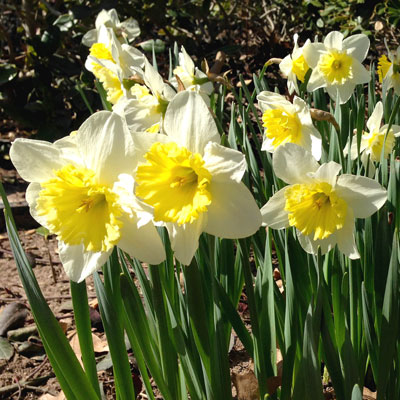Ice Follies Love Texas!
If you want daffodils that are truly perennial – that will come back year after year – there are several names to remember. Ice Follies are at the top of my list, but Carlton is one of the most popular types in the world, and I’ve had good luck with Geranium, Suzy, Cheerfulness and Yellow Cheerfulness. For the most part, your goal should be to buy early- and small-flowering types. The words “large” and “late” are not good to have associated with daffodil varieties.

Ice Follies daffodils bloom for probably 20th straight spring in Sperry gardens
Buy high-quality bulbs from reputable, full-time nurseries or bulb houses. Avoid “bargain bulbs” sold at a discount by the big national chains. They’re almost guaranteed to disappoint.
Plant your bulbs into well-prepared perennial garden soil to which you’re added generous amounts of organic matter and 1 inch of expanded shale. They should be planted two to three times as deep as the bulbs are tall. It’s more effective if you’ll plant them in clusters instead of in long rows across the fronts of your beds. Space the bulbs 4 or 5 inches apart so they can make a solid mass of color while they’re blooming. You want to see daffodils as a community, not individually.
Your daffodils can be planted pretty much whenever you find them in garden centers in fall. They do not require the pre-cooling that we must give tulips and Dutch hyacinths (45 days at 45 degrees in the refrigerator before planting the second half of December). Daffodils and their cousins can be planted as soon as you get them home. They will not need to be fertilized, and you’ll only want to water them as needed during extended dry spells in winter and early spring.
Once they finish blooming in spring, leave your daffodils’ leaves in place until they turn completely brown. It’s tempting to trim them off, but they are very necessary for storing foods to boost the following year’s blooms.
The types to avoid? Large- and late-flowering types such as King Alfred, Mount Hood and Unsurpassable. They’ll bloom the first year, but after that they’re pretty much going to “go all to leaves.” In fact, they almost look like liriope groundcover for a couple of months. They just don’t have the oomph to come back to bloom a second spring.

